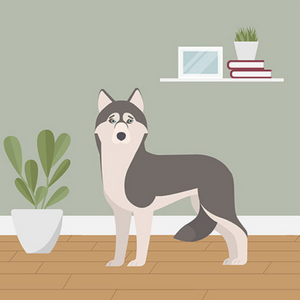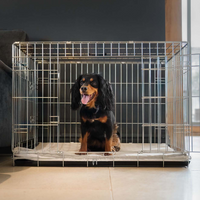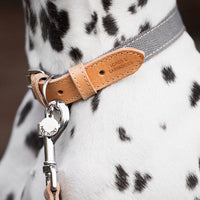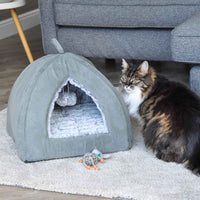What we search for online can reveal quite a lot about us, and if you’re a dog owner, your search history might disclose a thing or two about your furry friend too. Many of us consult ‘Doctor Google’ to find out about our own health conditions, so it’s no surprise that more and more of us are going online to learn about our pets’ health issues. And we’re not just talking about physical health. Growing mental health awareness seems to have translated into the world of pets too, with many dog owners turning to the web for information on how to care for their dog’s mental health and wellbeing.
Here at Lords & Labradors, we’ve looked at online search trends to find out which mental health conditions people in the UK are looking up the most. In this blog post, you’ll discover the findings of our research, along with tips on supporting your canine friend’s wellbeing.
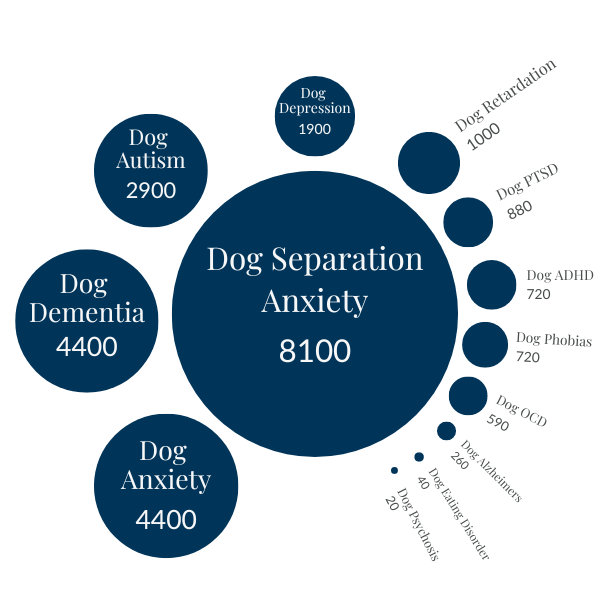
Separation Anxiety Is The Number One Concern
Separation anxiety in dogs seems to be the canine mental health issue that we’re most concerned about as a nation, with the term ‘dog separation anxiety’ being searched 8,100 times a month on average. General anxiety is also a cause for concern, with the term ‘dog anxiety’ getting 4,400 searches on average a month.
While this subject can often crop up among dog owners anyway - particularly with breeds that are prone to separation anxiety, such as Labrador Retrievers, Border Collies and Cavalier King Charles Spaniels - the lifting of COVID-19 restrictions will no doubt have had an impact on people’s interest in this topic. As people return to work and education, and resume more of their usual social activities, it’s likely that many pet owners will be concerned about how their dog will cope with increased alone time.
Worried about this issue? Common behavioural signs of separation anxiety include
- Destroying furniture or other household items
- Increased howling, barking or whining
- Toileting problems
- Trembling
- Repetitive behaviour
There are a variety of ways you can support a dog struggling with separation anxiety. It may help to give them a snuggly toy for comfort or a mentally-stimulating toy to keep them engaged when you’re not there. You should also ensure that your dog gets plenty of exercise and the opportunity to go to the toilet before you leave so they can relax while you’re gone. You could also hire a dog sitter to keep your dog company, or you might decide to consult a vet or clinical animal behaviour specialist for advice or guidance.
Canine Dementia Is Another Big Area Of Interest
With dogs living longer than ever before, canine dementia - officially known as Cognitive Dysfunction Syndrome, is becoming more prevalent. On average, the term ‘dog dementia’ is searched online 4,400 per month and ‘dog Alzheimer’s’ gets 260 monthly searches. Much like Alzheimer’s in humans, in dogs the condition affects the ageing brain and can lead to memory problems, confusion, disorientation and anxiety.
Worried about this issue? Common Symptoms of canine dementia:
- Disorientation or confusion
- Lack of response to usual commands
- Changes in activity levels
- Vocalising more than usual
- Eating more or less than usual
- Increased sleeping during the day
- More frequent night waking
- Changes in toileting behaviours
If you notice any of the above symptoms please contact your vet.
Autism On Dog Owners’ Radar
‘Dog autism’ gets around 2,900 searches a month on average. While it may not be an official diagnosis in veterinary practice, the growing awareness of autism in humans may have some dog owners questioning whether or not their pet behaviours might be typical of autism spectrum disorder.
Worried about this issue? While your dog may not be given a diagnosis of autism, it’s important to be aware of unusual communication or social behaviours or inappropriate reactions to stimuli, and you should be sure to seek professional support or advice if you have concerns.
Depression And Dogs
Every month, approximately 1,900 searches for the term ‘dog depression’ are performed using Google. If you’re wondering if dogs can actually become depressed, the answer is yes. While their condition may not be as complicated as depression in people, dogs sadly can experience a form of depression and display symptoms such as reduced interest in exercise and play, lethargy, decreased appetite and behavioural changes.
Worried about this issue? If your dog seems down, you should ask yourself the following questions:
- Has your dog’s life changed in any way recently?
- Is your dog getting adequate exercise?
- Is your dog being mentally stimulated?
- Does your dog have the opportunity to play?
- Does your dog get enough quality time with you?
- Does your dog have any other physical or behavioural problems that may need to be investigated?
Once you’ve asked yourself these questions, you should be able to identify what you need to do to improve your dog’s mood. For example, you might find out that your dog needs more exercise, increased physical contact with you or more boredom-busting activities. You might also decide that your dog needs to be examined by a vet to rule out physical health problems.
Other Canine Mental Health Concerns
A number of other search terms related to mental health conditions came up in our research, including ‘dog PTSD’ with 880 searches per month on average, ‘dog adhd’ with 720, ‘dog phobias’ with 720, ‘dog OCD’ with 590, ‘dog eating disorder’ with 40 and ‘dog psychosis’ with 20.
If you have concerns about your dog’s mental health, it’s important to seek advice from a vet or qualified clinical animal behaviourist.
Top 5 Tips To Boost Your Dog’s Mental Wellbeing
1. Exercise
Exercise is vital to your dog’s physical and mental wellbeing. How much physical activity your dog needs every day will depend on the breed and age of your four-legged friend. For example, while Bichon Frise, Yorkshire Terriers and Maltese dogs may be ok with just 30 minutes exercise plus play time a day, a Whippet, English Bulldog or Cocker Spaniel may need an hour or more of exercise a day. Other dogs, like Golden Retrievers, Dalmatians and German Shepherds, meanwhile, need in excess of two hours of physical activity a day to stay well. You can exercise your dog in a number of different ways. In addition to walking them daily, you could play ball games, go running with your dog or make them work for their food with fun feeding toys.
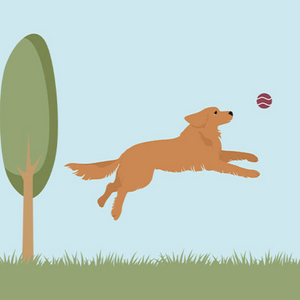
2. Mental Enrichment
Just like people, dogs can get bored so it’s important to keep them stimulated to help maintain their mental wellbeing. There are plenty of engaging and interactive toys that you could try out with your pooch, from dog puzzles, to snuffle mats, to activity balls. You should also spend time chatting to your dog and try to keep them mentally astute by teaching them new tricks from time to time.
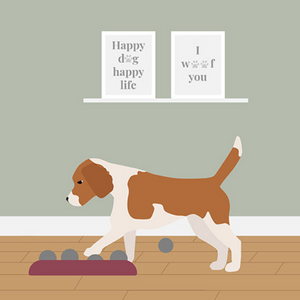
3. Physical Touch
Tactile communication is very important to dogs. You can help enhance your dog’s wellbeing, develop their sense of security and trust, and cement your bond with them by spending time petting, grooming and snuggling with your furry pal.
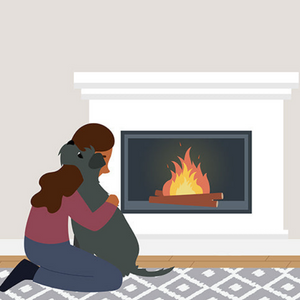
4. Nosework
Nosework is an activity that allows your dog to tap into their natural hunting instinct. There are plenty of nosework games you can play that will give your dog the chance to problem solve while doing something they love - sniffing. For example, you could hide food in another part of the room and command that they ‘find it’ or you could hide food in one of your hands and present your dog with two closed fists and ask them ‘which hand?’

5. Body Language
Pay attention to your dog’s body language to find out what they’re trying to tell you. If you make a conscious effort to do this, you’re likely to better understand signs that they’re becoming stressed, anxious, scared or sad. Avoiding eye contact can be a sign of anxiety, for example, while growling or tucking their tails in can indicate that your dog is fearful, and if your dog is feeling vulnerable, they might roll on their backs more than usual.
